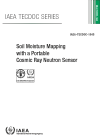The miniaturization of computers makes it increasingly possible to use mobile instruments to detect and measure radiation. The IAEA supports its Member States in deploying such technology in real world situations, such as earthquake disaster zones or mining areas. Mobile instruments can also be used to study historical artefacts.
Mobile instrumentation
The IAEA’s work in this area crosses a number of disciplines and involves a range of nuclear techniques.
The principle mobile instrument used to identify radiation in the environment is the gamma radiation detector. While gamma radiation is part of the environment’s normal background radiation, some places have higher levels of gamma radiation, either for natural reasons or due to human activities. Such activities may influence the normal environmental radiation through the concentration of natural materials or as a result of an accident, during which radiation is released from a nuclear facility.
In any of these cases, instruments such as Geiger-Muller detectors, scintillation detectors or semi-conductor detectors, equipped with global navigation sensors, can map and monitor environmental radiation. Measuring and quantifying gamma rays in the environment not only yields information on the amount of radioactive materials in the environment, but also on where the radioactive isotopes come from, their physical source, and how or if the radiation is moving around.
The IAEA maintains the ENVIRONET network, through which it supports its Member States in characterizing radiologically impacted areas on-site. It also provides Member States assistance through its technical cooperation programme. The Agency, together with international experts, has surveyed and characterized a number of sites in Africa, Latin America, Europe and Asia, using various mobile instrumentation technologies.
Using mobile systems for cultural heritage preservation
Handheld x ray fluorescence spectrometers are extremely useful for the study of art works in museum collections. The possibility of bringing such instruments to inspect the objects on-site facilitates the study of artefacts that cannot be moved either due to their extreme fragility or their large size or weight. In addition, non-destructive analysis constitutes a preferred alternative to invasive sampling techniques, which are usually not permitted in the study of unique or extremely valuable objects.
On-site examinations can help determine the chemical composition of materials used for historical artefacts and estimate the material’s thickness. It can also yield information on the historical use of pesticides during restoration, which represents important safety information for museum staff.





